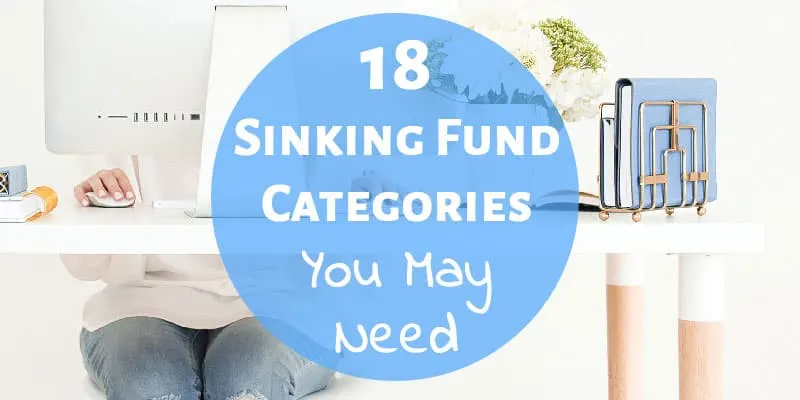Sinking fund categories are a vital part of our budget! They help keep our monthly budget spending pretty much the same even though our expenses may vary greatly.
For instance, we spend a lot more money in November and December because we’re buying Christmas presents, but my monthly budget doesn’t look any different because I’ve been using a sinking fund all year long to save up for this extra spending.
This is super helpful, especially when you’re on a tight budget and don’t have enough extra each month to cover any irregular bills or expenses.
In previous years, it would have been impossible to come up with an extra $240 in December to buy Christmas presents. However, by making it a part of our monthly budget, I could easily save $20 per month all year long.
There are tons of different sinking fund categories you can set up, so we’ll cover a bunch of them to help you get started!
Table of Contents
What is a Sinking Fund?
Simply put, sinking funds are savings accounts that you regularly put money into so that you can gradually save up for a big bill or expense. They are especially helpful when you’re on a tight budget and don’t have enough extra cash in a given month to cover a large expense such as an expensive car repair or hospital visit.
To learn more about the definition of a sinking fund and to see more examples, you can check out this post: What are sinking funds? (definition and examples).
How Many Sinking Fund Categories do you Need?
Depending on the bills and expenses you have, you might want to have several categories of sinking funds or just a couple. I’ll share the sinking fund categories we have and some ideas of other ones that might be helpful for you.
Here are the 10 sinking fund categories we personally used last few months, and the amount that gets deposited every month:
- Medical: $10.00
- Car: $20.00
- Mozzie (our dog): $40.00
- Gifts: $15.00
- Christmas: $20.00
- Water & Trash City Bill: $25.00
- House Repairs: $10.00
- Life Insurance: $33.00
- Giving: $100.00
- Grocery Trip to the City: $25
If you’re wondering about the logistics of how to set money aside for sinking funds, check out this post about three methods you can use.
But our situation is probably different from yours, so I have compiled below a more extensive list of 18 sinking fund ideas that might work for you.
18 Sinking Fund Categories You Might Need in Your Budget
Below are the sinking fund categories we have contribute to in the last few years. A lot of times the amount we add is not huge, but it builds up over time.
We do our best to save up for car repairs because we know they will eventually happen. However, if something really expensive were to happen, we have an emergency fund to back us up since our $20 per month isn’t much.
I’ve included the amount we put in each fund per month because I think it is helpful to see what other people do so that I can make adjustments for my own situation from there.
Ideally, we would contribute larger amounts to a lot of these funds, but it’s not in the budget right now. I figure anything is better than nothing, though!
Car Repair
We know that all cars eventually need some work done, even if it’s just oil changes and tire rotations. We put $20 per month in this fund.
Water Bill
Our water bill is quarterly, so I like to save up a little each month to go toward it. We also use this account for our trash bill since those both get paid to the city. We put $70 per month in this fund.
Pet Costs
Mozzie is expensive y’all! He gets groomed regularly, requires food and treats, plus annual vet visits. We put $30 per month in this fund, which really isn’t enough to cover vet costs but is enough to pay for grooming and food for him.
Gifts (Non-Christmas)
I divide out gifts for things like for birthdays, weddings, or mother’s day, from money we save for Christmas gifts. I wouldn’t want to eat into our Christmas money with other gifts during the rest of the year. We put $30 per month into this fund.
Christmas
Our Christmas fund is mostly for gifts, though we might use some of it for sending Christmas cards or extra special foods we buy for the holidays. We put $30 per month into this fund.
Home Repairs
Stuff breaks. It sucks. This fund isn’t large enough to handle any huge repairs, but it helps us out on all of the little things. We put $40 per month into this fund.
Life Insurance Bill
This is an annual bill for us and it’s a big one, so I’m always glad to have the money on hand to pay it! We put $33 per month into this fund.
Medical Costs
Even with good insurance, we still have a deductible plus co-pays for appointments. This fund helps cover all of that, plus any cold or flu meds we might need. We add $40 per month to this fund.
Clothes & Shoes
We don’t buy clothes and shoes every month, so I add money to a sinking fund for them. I prefer to buy long-lasting, higher quality items when I do shop, so it helps to have money saved up for a while because that stuff is expensive! We put $40 per month into this fund.
Allowance
Austin and I each get monthly allowances! Some people call this fun money or blow money. It’s the money we can spend on whatever we want. I usually end up buying jewelry or books. Austin spends his on video games. I often go months without using my allowance, so I like to keep it in a separate sinking fund. This is actually two funds, one for me and one for Austin. We each get $20 added to our allowance funds each month.
Giving
We don’t give regularly to any churches or charities, so we add giving money to a sinking fund. When we come across a non-profit or a cause that we’d like to support, we have money set aside to do so. This fund gets $50 added to it monthly.
By the way: One of the very best things you can do to start getting a handle on your finances is track your spending! You can download and print my free spending tracker printable and take action today!
[convertkit form=980628]
Other Ideas for Sinking Fund Categories
Depending on your life and money situation, you may want to have some of the sinking funds listed here.
Car Replacement
To keep you from getting a car loan when you need a new one, you could be saving up monthly to replace your vehicle.
Emergency Fund
If your emergency fund is not fully funded or you want to keep building it, you could set up regular deposits to this account.
House Downpayment
It’s hard to come up with a huge chunk of money for a house downpayment without some regular savings. This would be a great sinking fund to help you save up slowly over time.
Membership Renewals
Yearly memberships can easily throw off your budget. You might pay annually for Sam’s Club, Amazon Prime, the zoo, and a neighborhood pool. Why not make a sinking fund that allows you to gradually save up for membership fees so that you’re not caught off guard?
Travel
Don’t forget the fun stuff! $100 per month means you could take a $1200 vacation each year. Not too shabby.
Kids’ Activities
If your kids participate in a lot of activities or attend summer camps, it might be helpful to save up for those all year round.
Tuition
You might pay for private school, preschool, or be saving up for your own tuition. If you add money to this fund all year, you’re less likely to go into debt for education.
Conclusion
Having sinking fund categories have always been great for helping us save up for bills and expenses that don’t occur every month. They keep me from stressing about these things and allow our monthly budget to stay relatively the same month to month.
To learn how to set up your sinking funds, read this post about three ways to create them.
You Might Like These Posts Too:
- What are Sinking Funds? (definition and examples).
- How to Avoid Frugal Burnout
- How We’ve Lived on One Income for 8 Years
- Living on $2500 Per Month: Our Actual Monthly Budget
⇒ Did you find this post helpful? Pin or share it!





Ndilimeke Shikongo
Wednesday 18th of August 2021
Where do you keep all these sinking funds? Bank or envelops?
Christine
Wednesday 25th of August 2021
Hi - we personally have a separate saving account at the bank where we transfer money. An envelope could work if you prefer working with cash!